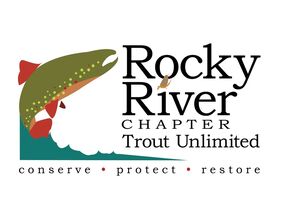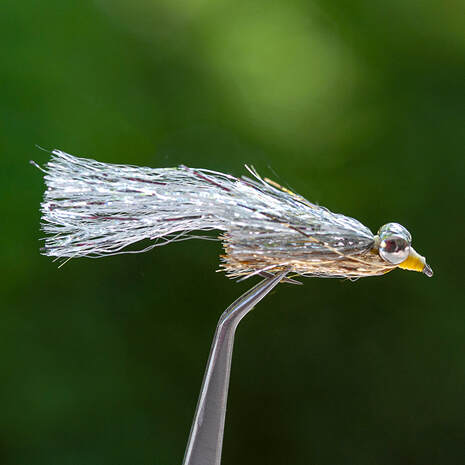Fly of the Month 10.20
Fly tying began with natural fur and feather materials and has endured through many centuries of genetic breeding as well as loss of species. The Yellarhammer feathers are federally protected, thus a substitution of dyed-quail feathers are used. Many Atlantic salmon fly patterns require substitutions as birds and wild game have dwindled into threatened, endangered or even extinct classifications. However, modern chemical engineering and manufacturing processes now produce artificial fur, hair and feathers in almost any color imagined. These synthetic materials are becoming the substitutes and leading to thousands of new fly patterns. One simply needs to tied the material on a hook in a creative way and go try it on fish. This is a case where the tiny brain of a fish does not seem to be able to tell any difference. In fact, adding gleam, glitter and unusual color seems to attract both the angler and fly tyer as well as the fish. One such fly pattern fully utilizes gleam, glitter and color. It is the ….
Kreelex Minnow
or Kreelex Streamer
The Kreelex Minnow is a “flash fly” that is simple to tie, easy to cast and gives off a lot of light and movement that attracts fish. It is tied much like a Clouser Minnow. Some anglers consider the Kreelex a modern wonder fly and the holy grail of all streamers. Some say the fly is ugly but catnip for fish. Some say a game changer!
Chuck Kraft designed this fly literally in his sleep prior to a trip to Chile to guide for the season. Chuck has been very close to winning multiple “One Fly” Tournaments in Jackson, Wyoming using his creation. The fly pattern was intended for targeting trout, but it has proved to be a deadly pattern for any gamefish including bass, redfish and carp. The fly pattern has a reputation for attracting and landing big fish and for being an absolute killer anywhere in the world.
The original fly pattern was created using both silver and gold kreinix flash and Dazl-Eyes using a 3x or 4x long streamer hooks. The fly pattern has been further developed using kreelex flash (same product, different brand name) which has a metallic like finish that glows like a lantern underwater and has a little softer consistency than Flashabou. Kreelex is a fine-fiber synthetic with a metallic like gleam that is easy and simple to tie. No coating or special glue is needed, and the material holds up very well in saltwater. The dumbbell eyes may be plain lead eyes or fancy painted or realistic eyes. The dumbbell eyes allow the fly to be stripped with the hook up, thus preventing much of the potential bottom snagging.
Color combinations may be endless for this fly pattern. Also, variations have been developed using Flashabou and other similar synthetic flash materials. Example Variations:
Silver Kreelex Variant using Speckled plus Silver Flashabou and Dyed-Pearl plus Black Flashabou.
Gold Kreelex Variant using Speckled plus Gold Flashabou and Dyed-Pearl plus Black Flashabou.
Copper Kreelex Variant using Speckled plus Copper Flashabou and Dyed-Pearl plus Orange Flashabou.
Many guides have become the inventors of unique new fly patterns. The fly patterns are typically simple and easy as a guide has precious little time to spend at the tying bench. The fly patterns typically involve only a few materials that help to conserve costs. The net time you book a float trip or a guided wading trip, as the guide about his personal favorite fly patterns. Most likely he will rattle off a few you recognize and along with that one or more of his very own creations. Fly fishing keeps evolving. Kreelex is one of those materials that is making it happen.
Tom Adams and Alen Baker
References:
Internet; Jack McNeary RRTU Beginner’s Fly Tying Class
Fly tying began with natural fur and feather materials and has endured through many centuries of genetic breeding as well as loss of species. The Yellarhammer feathers are federally protected, thus a substitution of dyed-quail feathers are used. Many Atlantic salmon fly patterns require substitutions as birds and wild game have dwindled into threatened, endangered or even extinct classifications. However, modern chemical engineering and manufacturing processes now produce artificial fur, hair and feathers in almost any color imagined. These synthetic materials are becoming the substitutes and leading to thousands of new fly patterns. One simply needs to tied the material on a hook in a creative way and go try it on fish. This is a case where the tiny brain of a fish does not seem to be able to tell any difference. In fact, adding gleam, glitter and unusual color seems to attract both the angler and fly tyer as well as the fish. One such fly pattern fully utilizes gleam, glitter and color. It is the ….
Kreelex Minnow
or Kreelex Streamer
The Kreelex Minnow is a “flash fly” that is simple to tie, easy to cast and gives off a lot of light and movement that attracts fish. It is tied much like a Clouser Minnow. Some anglers consider the Kreelex a modern wonder fly and the holy grail of all streamers. Some say the fly is ugly but catnip for fish. Some say a game changer!
Chuck Kraft designed this fly literally in his sleep prior to a trip to Chile to guide for the season. Chuck has been very close to winning multiple “One Fly” Tournaments in Jackson, Wyoming using his creation. The fly pattern was intended for targeting trout, but it has proved to be a deadly pattern for any gamefish including bass, redfish and carp. The fly pattern has a reputation for attracting and landing big fish and for being an absolute killer anywhere in the world.
The original fly pattern was created using both silver and gold kreinix flash and Dazl-Eyes using a 3x or 4x long streamer hooks. The fly pattern has been further developed using kreelex flash (same product, different brand name) which has a metallic like finish that glows like a lantern underwater and has a little softer consistency than Flashabou. Kreelex is a fine-fiber synthetic with a metallic like gleam that is easy and simple to tie. No coating or special glue is needed, and the material holds up very well in saltwater. The dumbbell eyes may be plain lead eyes or fancy painted or realistic eyes. The dumbbell eyes allow the fly to be stripped with the hook up, thus preventing much of the potential bottom snagging.
Color combinations may be endless for this fly pattern. Also, variations have been developed using Flashabou and other similar synthetic flash materials. Example Variations:
Silver Kreelex Variant using Speckled plus Silver Flashabou and Dyed-Pearl plus Black Flashabou.
Gold Kreelex Variant using Speckled plus Gold Flashabou and Dyed-Pearl plus Black Flashabou.
Copper Kreelex Variant using Speckled plus Copper Flashabou and Dyed-Pearl plus Orange Flashabou.
Many guides have become the inventors of unique new fly patterns. The fly patterns are typically simple and easy as a guide has precious little time to spend at the tying bench. The fly patterns typically involve only a few materials that help to conserve costs. The net time you book a float trip or a guided wading trip, as the guide about his personal favorite fly patterns. Most likely he will rattle off a few you recognize and along with that one or more of his very own creations. Fly fishing keeps evolving. Kreelex is one of those materials that is making it happen.
Tom Adams and Alen Baker
References:
Internet; Jack McNeary RRTU Beginner’s Fly Tying Class
Kreelex Minnow
Hook : Tiemco 300 Streamer fly or equivalent in size 4,6,8,10,12
Thread : White GSP or 3/0
Body, Tail and Beard : Kreelex minnow flash in silver and gold or many variations to suit
Eyes : Brass dumbbell eye
Directions :
Hook : Tiemco 300 Streamer fly or equivalent in size 4,6,8,10,12
Thread : White GSP or 3/0
Body, Tail and Beard : Kreelex minnow flash in silver and gold or many variations to suit
Eyes : Brass dumbbell eye
Directions :
- Debarb and mount the hook. Attach thread starting about a third back from the eye. Continue wrapping in touching turns to the hook point and then returning to the start.
- Place the dumbbell on top of the hook shank at the one third mark and make x wraps to hold it in place.
- Take the thread back to the hook point in touching turns and select a hank of silver kreelex. Wrap the kreelex around the thread once and place on top of the hook shank for position. Secure the kreelex with several firm wraps and bring the thread to in front of the dumbbell eye. Trim the kreelex tail to about a hook length past the hook bend.
- Repeat the process but secure the kreelex in front of the dumbbell eye and then take the thread immediately behind the eye for several more wraps to bind the kreelex on top of the hook to form a wing. Take the thread back in front of the dumbbell eye and trim the wing to the length of the hook shank.
- In a rotary vise rotate 180 degrees, in a non rotary remove the hook and re attach it “upside down”.
- Select a hank of gold kreelex and repeat the process but do not take the thread behind the dumbbell eyes. Form a nice and even thread head and cut away the waste.
- Cut the gold kreelex to the same length as the silver kreelex wing.

